|
|
Period:
First World War
Region:
Austro-Hungary
The Austro-Hungarian camp in Veľký Meder 1914
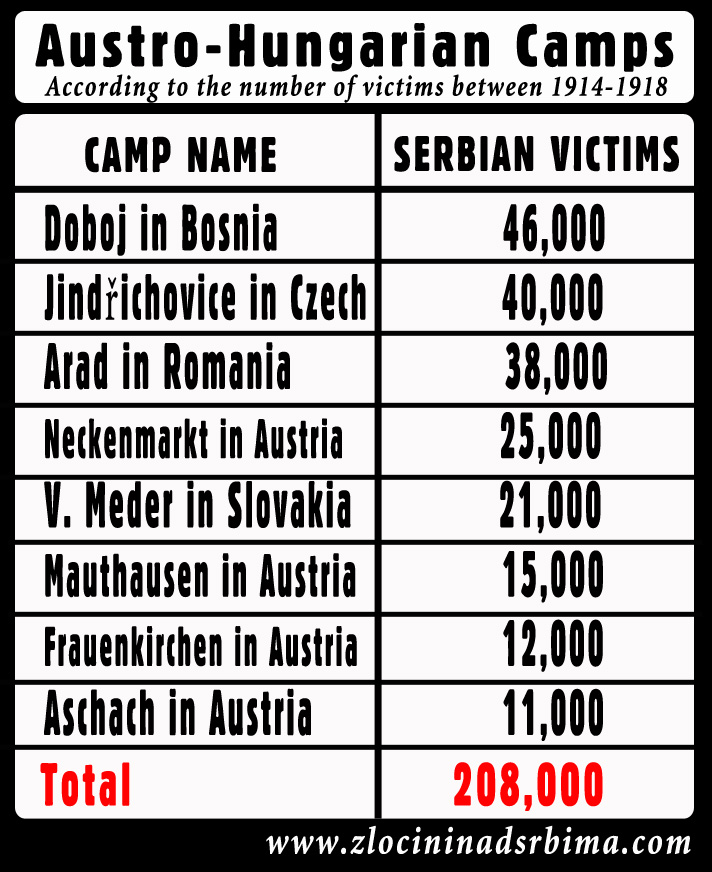 The Veľký Meder was a concentration camp established under the instruction of the Royal Palace of Vienna in World War I. it was located 60 km (37 miles) south of Bratislava, on the territory of today’s Slovakia. The Nagymegyer camp operated from the 3rd September 1914 until the 31st October 1918. The Veľký Meder was a concentration camp established under the instruction of the Royal Palace of Vienna in World War I. it was located 60 km (37 miles) south of Bratislava, on the territory of today’s Slovakia. The Nagymegyer camp operated from the 3rd September 1914 until the 31st October 1918.
In the Veľký Meder Camp, around 21,000 Serbs were imprisoned (civilians and soldiers), and around 6,000 didn’t return but were killed or died from hunger, cold, disease, etc.
Austro-Hungarian authorities had, on its territories, dozens of concentration camps, in which over 300,000 Serbs, civilians, and soldiers, mostly from areas of Šumadija, Timočka Krajina, Montenegro, Bosnia and Herzegovina, Raška, of whom less than two-thirds managed to survive and return to their homeland. This clearly shows the genocidal intentions of the Habsburg Empire towards Serbs.
In Veľký Meder, between two world wars, a monument was raised for the victims who were imprisoned here during the four years of the War 1914-1918. This memorial compound is one of the four largest military cemeteries (after Jindrichovice, Zeitenlik, and Mauthausen) that were outside of Serbia.
From 1946 till 2001 the cemetery in Veľký Meder was largely neglected, even turned into a race track for dogs. Later, under the initiative of the Serbian community in Slovakia, it was renovated. Also, some means were donated by the Government of Serbia in 2003.
|
FIRST WORLD WAR 1914-1918 |
|
Battles of: Cer, Drina, Kolubara, Leget, Cemerno, Mojkovac, Kajmakcalan, Gornicevo, Dobro Polje
Camps: Mauthausen, Arad, Jindrihovice, Broumov, Boldogasonj, Nadjimer, Nezider, Aschah, Doboj, Sliven
Crimes: Macva, Surdulica, Great Retreat, Sabac
|
BACKGROUND
At the beginning of 1904, the Kingdom of Serbia signed a trade agreement with the USA, France and Russia... and began exporting its products to the overseas countries through the port of Thessaloniki.
This led to a great economic upswing of the Kingdom of Serbia, which annoyed the Vienna Court, which viewed Serbia as a great rival since Serbia had the highest economic growth rate in Europe at the time, and at the same time a large number of Serbs lived in the occupied territories of the Habsburg Monarchy.
Map of south-eastern Europe in November 1913.
The army of the Kingdom of Serbia liberated its enslaved territories (Raska, Kosovo and Metohija and Old Serbia) from the Turks in the First Balkan War, by achieving major victories in the fall of 1912 at the command of Duke Petar Bojovic at Kumanovo, Prilep and Bitola, and as such completely expelled the Ottomans from the Balkans.
And a year later in the summer of 1913 the army of the Kingdom of Serbia protected Vardar Macedonia from the Bulgarians in the Second Balkan War. The Serbian national revolution was thus continued, at the beginning of the 19th century by Karadjordje Petrovic and Milos Obrenovic.
In the summer of 1914, the Austro-Hungarian Monarchy used the Sarajevo assassination, that is, the assassination of Austrian Crown Prince Franz Ferdinand by members of Young Bosnia (Gavrilo Princip, Bogdan Zerajic, etc.) as an excuse to invade the Kingdom of Serbia, thus starting First World War.

Gavrilo Princip and his comrades in Sarajevo
A dispatch was sent from Vienna, which no sovereign state could accept. Thus, in late July 1914, Austria-Hungary declared war on Serbia. Montenegrin King Nikola I Petrovic and Russian Emperor Nikolai II Romanov immediately sent messages saying that they would help the Serbs. Likewise, German Emperor William II made a military alliance with the Vienna Palace.
INCEPTION
The Concentration camp in Veľký Meder was established at the beginning of World War I, on 3rd September 1914, when soldiers of the Kingdom of Serbia were brought after being captured on the mountains of Cer, Suvobor, Mačva, and Srem region.
Also, entire Serbian families captured in Šumadija, Raška, Timočka Krajina, Montenegro, and Bosnia were brought into the camp because their sons or father were in the Serbian army.
The location of Veľký Meder was on the Danube river island, around 60km (37 miles) south-east of Bratislava (Capital of Slovakia), in the vicinity of the Hungarian small town of, Nagymegyer, on today’s border between Slovakia and Hungary. Today in Serbia, this place is called Čalovo.
ESTABLISHMENT
The Veľký Meder Camp had 36 cottages, which together could house between 6,000 and 12,000 inmates.
There were no mass shootings and massacres, but Serbian detainees massively died of hunger, cold, sickness, etc. Austro-Hungarian policies imposed the preservation of ammunition, which meant that Serbs were to be killed without a bullet shot.
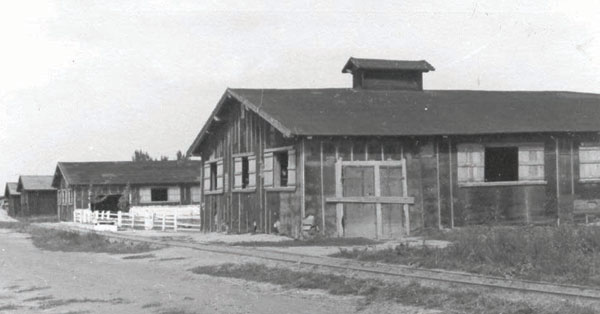
Example of cottages from the former concentration camp in Veľký Meder
CAMP CONDITIONS
Records show that 2,900 Serbs died, mostly of hunger and cold in just two months from the end of 1915, until the beginning of 1916. Serbs were also massively dying of typhoid fever.
Medical care in Austro-Hungarian dungeons was under any expectations. The emergence of Typhus had further increased the sufferings of the Serbs. The main characteristic of Austro-Hungarian camps, including the one in Veľký Meder, was that many diseases were emerging above any expectations due to poor hygiene. The extent to which these conditions were horrible was shown by the fact that most of the doctors who were there, left (fled) from the camp.
The care for the destinies of the sick was taken by three doctors-inmates: dr. Dragomirović, dr. Zarubica and dr. Martinović. The latest data shows that around 6,000 Serbs died here, while there were 8,000 Serbian victims in the entire Slovakian territory.
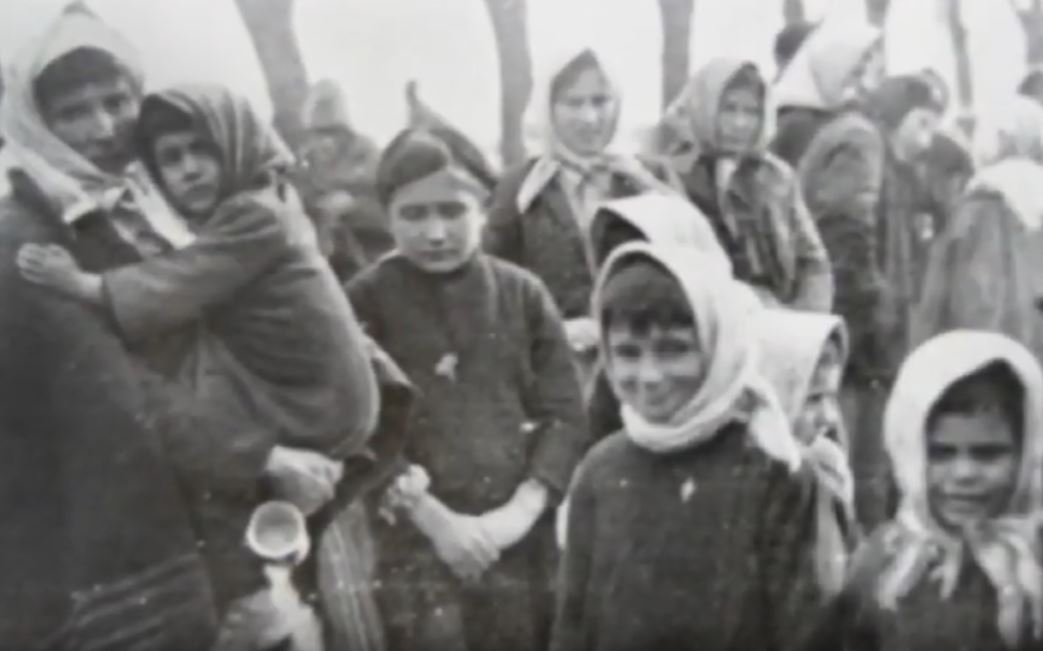
Children and women in austro-hungarian camps in WW1
In this camp, on average 85 people died daily. Over 150 of them were buried without a name label or tombstone. Everyone was buried in the swamps of Danube.
On the 20th September 1914, the first inmate was buried: Nikola Nikolić, while on the 29th October 1918, just two weeks before the end of World War I, the last inmate of Veľký Meder was buried: Bogdan Nikolić.
CLOSURE
The Veľký Meder death camp was destroyed on the 31st October 1918, just several days before the Austro-Hungarian monarchy disintegrated. From then on, the inmates were set on a journey to their homes, some by train, and a few on foot.

Images of gravesites in Veľký Meder
YEARS LATER
The first list of inmates and victims was gathered by a former inmate Risto Kovijanić. This cemetery was visited by Duke Petar Bojović when he said that Veľký Meder is – A Serbian ossuary.
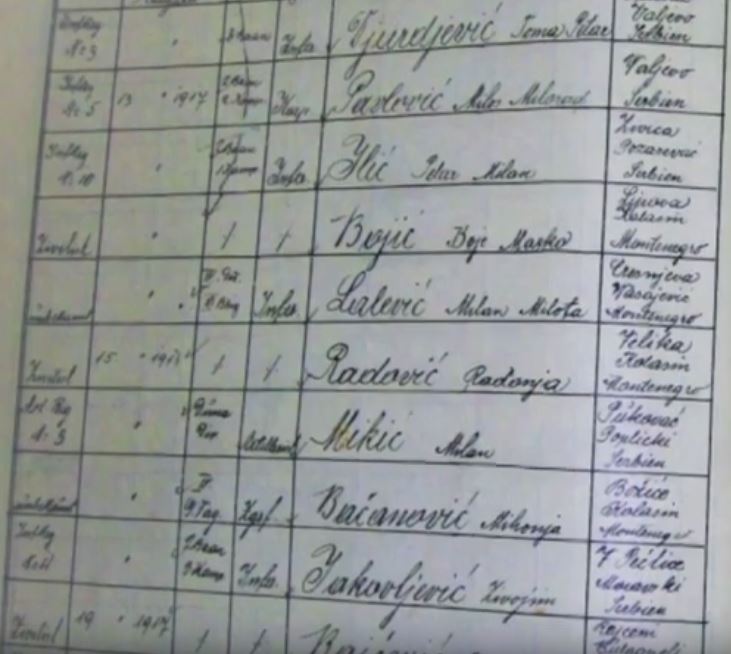
Lists of inmates according to the camp’s records
Yugoslav communist authorities after World War II did not pay any attention to these death sites of Serbs in World War 1 so that for several decades these graves were unattended and, accordingly, left neglected and overgrown in weeds while the chapel was ruined. The Czechoslovakian after-war communist authorities did not pay any attention to these death zones either.
As this was not enough, local Hungarian authorities, in the 1990s, rented out that part of the land to the local Kennel club that organized dog races.
Only in 2001, this place of horrors was visited by Dr. Nebojša Kuzmanović, on the behalf of the Provincial secretariat of culture AP Vojvodina, which investigated Serbian deaths in Slovakia. Therefore, in October 2001 the Government of Slovakia annulled the decision of the local Hungarian authorities.
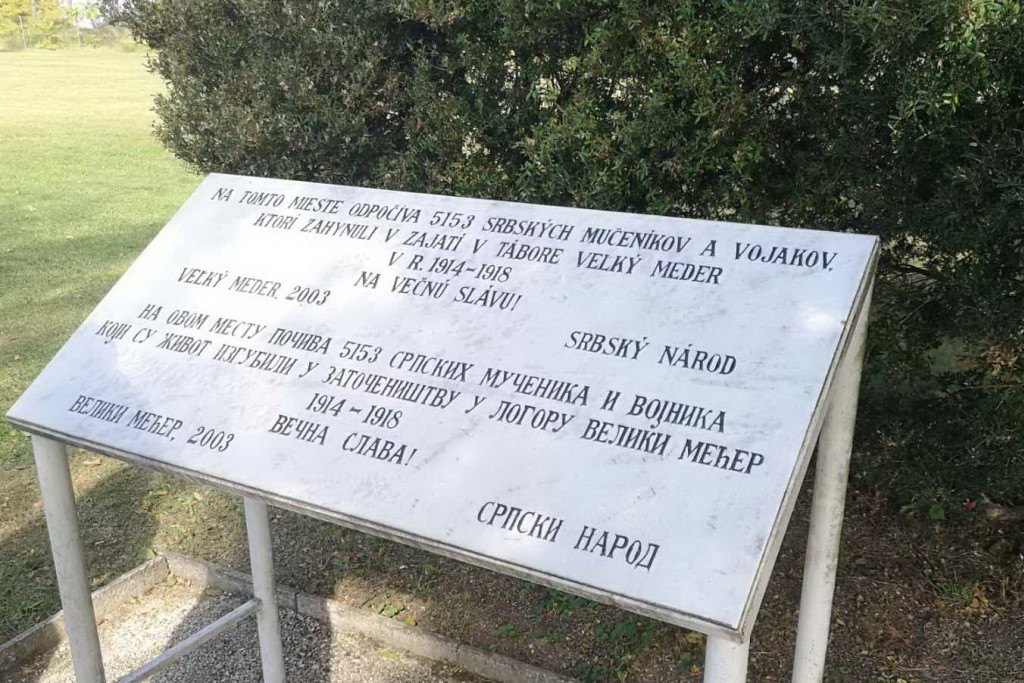
Monumental Plate in today’s memorial compound
Little later, representatives of the Community of Serbs “Svetozar Marković” from Slovakia initiated an action of restoration of this cemetery which took two and a half years, where they have been gathering since 2004, usually on the victory day of World War II (11th November) and Vidovdan Serbian National Day (28the June).
In 2003, The Government of the Republic of Serbia set aside some financial aid for the restoration process of these death sites.
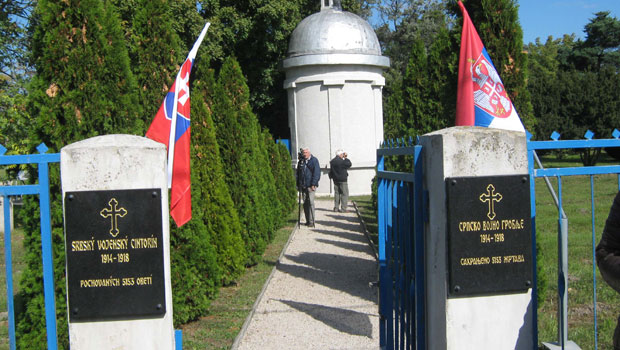
In 2012, Mayor of Veľký Meder accepted the initiative of the Serbian community in Slovakia that the street which leads to the former camp and the current cemetery is today called “Serbian street”.
On the territory of today’s Slovakia, there are eight more Serbian death sites: Komarno, Trnava, Zilina, Ilava, Banska Bistrica, and Šamorin which have military cemeteries with an unknown number of the dead soldiers from the Kingdom of Serbia.
In Trenčin, a monument with an ossuary was raised in 1928, in which 56 Serbian soldiers from World War I were buried.
PUBLICATIONS
The first who wrote about the sufferings of Serbs on the territory of Slovakia was Risto Kovijanić, who participated in three wars (2 Balkan and the Great War), and was imprisoned in two camps, one of them was, in fact, Veľký Meder where he had spent two years, and which he described in his work: “Nadjimerska dolina smrti“ (eng. "Nagymegyer’s Death Valley"). Kovijanić claimed that “Austro-Hungary had given a great contribution to cultural barbarism”.
 
In 2016, Isidor Djuković wrote a capital work: “Nagymegyer– Austro-Hungarian camps for Serbs 1914-1918”. On 408 pages, one can find precious data about the deaths of Serbs in this concentration camp, as the author himself was for a long period in Slovakia to investigate this forgotten and forbidden past.
Both books were published by the publishing house “Prometej” from Novi Sad.
Only one documentary film has been made until now.
Tags:
Please, vote for this article:
Visited: 2870 point
Number of votes: 7
|